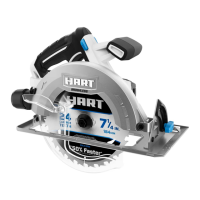4 - English
Kickback isthe result of saw misuse and/orincorrect
operatingproceduresorconditionsandcanbeavoidedby
takingproperprecautionsasgivenbelow:
Maintain a firm grip with both hands on the saw and
position your arms to resist kickback forces. Position
your body to either side of the blade, but not in line
with the blade. Kickbackcouldcausethesawtojump
backwards,butkickbackforcescanbecontrolledbythe
operator,ifproperprecautionsaretaken.
When blade is binding, or when interrupting a cut
for any reason, release the trigger and hold the saw
motionless in the material until the blade comes to a
complete stop. Never attempt to remove the saw from
the work or pull the saw backward while the blade
is in motion or kickback may occur. Investigateand
takecorrectiveactionstoeliminatethecauseofblade
binding.
When restarting a saw in the workpiece, center the
saw blade in the kerf so that the saw teeth are not
engaged into the material. Ifasawbladebinds,itmay
walkuporkickbackfromtheworkpieceasthesawis
restarted.
Support large panels to minimize the risk of blade
pinching and kickback. Largepanelstendtosagunder
theirownweight.Supportsmustbeplacedunderthe
panelonbothsides,nearthelineofcutandnearthe
edgeofthepanel.
Do not use dull or damaged blades. Unsharpened
orimproperlysetbladesproducenarrowkerfcausing
excessivefriction,bladebindingandkickback.
Blade depth and bevel adjusting locking levers must
be tight and secure before making the cut. Ifblade
adjustmentshiftswhilecutting,itmaycausebindingand
kickback.
Use extra caution when sawing into existing walls or
other blind areas. Theprotrudingblademaycutobjects
thatcancausekickback.
LOWER GUARD FUNCTION
Check the lower guard for proper closing before each
use. Do not operate the saw if the lower guard does
not move freely and close instantly. Never clamp or
tie the lower guard into the open position. If the saw
isaccidentallydropped,thelowerguardmaybebent.
Raise the lower guard with the retracting handle and
makesureitmovesfreelyanddoesnottouchtheblade
oranyotherpart,inallanglesanddepthsofcut.
Check the operation of the lower guard spring. If the
guard and the spring are not operating properly, they
must be serviced before use. Lowerguardmayoperate
sluggishlyduetodamagedparts,gummydeposits,ora
build-upofdebris.
The lower guard may be retracted manually only for
special cuts such as “plunge cuts” and “compound
cuts.” Raisethelowerguardbytheretractinghandle
andassoonasthebladeentersthematerial,thelower
guardmustbereleased.Forallothersawing,thelower
guardshouldoperateautomatically.
Always observe that the lower guard is covering the
blade before placing the saw down on bench or floor.
Anunprotected,coastingbladewillcausethesawto
walkbackwards,cuttingwhateverisinitspath.Beaware
ofthetimeittakesforthebladetostopafterswitchis
released.
ADDITIONAL SAFETY WARNINGS
Use clamps or other practical way to secure and
support the workpiece to a stable platform. Holding
theworkbyhandoragainstyourbodyisunstableand
mayleadtolossofcontrol.
Always wear eye protection with side shields marked
to comply with ANSI Z87.1 when assembling parts,
operating the tool, or performing maintenance.
Followingthisrulewillreducetheriskofseriouspersonal
injury.
Protect your lungs. Wear a face or dust mask if the
operation is dusty. Followingthisrulewillreducethe
riskofseriouspersonalinjury.
Protect your hearing. Wear hearing protection during
extended periods of operation.Followingthisrulewill
reducetheriskofseriouspersonalinjury.
Battery tools do not have to be plugged into an
electrical outlet; therefore, they are always in
operating condition. Be aware of possible hazards
when not using your battery tool or when changing
accessories. Followingthisrulewillreducetheriskof
electricshock,fire,orseriouspersonalinjury.
Do not place battery tools or their batteries near fire
or heat. Thiswillreducetheriskofexplosionandpossibly
injury.
Do not crush, drop or damage battery pack. Do not
use a battery pack or charger that has been dropped
or received a sharp blow. Adamagedbatteryissubject
toexplosion.Properlydisposeofadroppedordamaged
batteryimmediately.
Batteries can explode in the presence of a source
of ignition, such as a pilot light. Toreducetheriskof
seriouspersonalinjury,neveruseanycordlessproduct
inthepresenceofopenflame.Anexplodedbatterycan
propeldebrisandchemicals.Ifexposed,flushwithwater
immediately.
CIRCULAR SAW SAFETY WARNINGS

